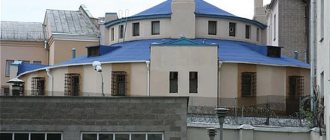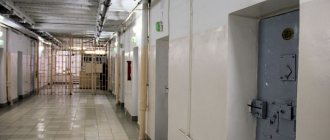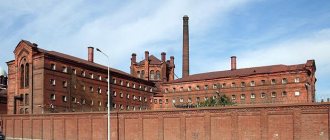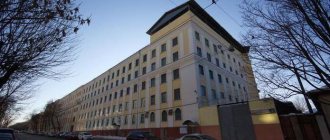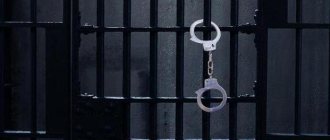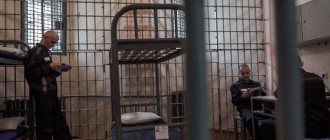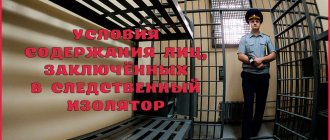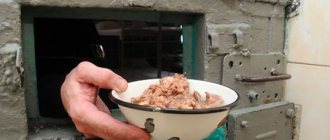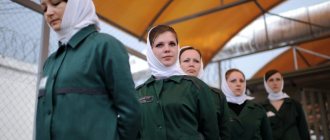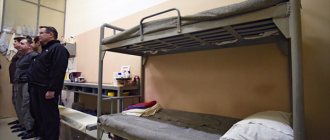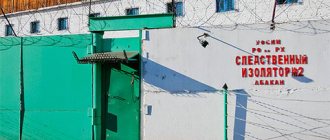One of the most famous Russian prisons, Kresty, appeared in the 19th century. It received this name among the people due to the cruciform arrangement of the buildings. The shape was not chosen by chance: in the center of the buildings there was an observer tower, which, due to its cross-shaped arrangement, had a clear view of what was happening there. There were no cameras or video surveillance systems then.
At the end of 2022, the old pre-trial detention center “Kresty” ceased to exist. All prisoners were transferred to the new building “Kresty-2”. Next, we will tell and show what the cells looked like inside the old “Crosses” (there were 999 of them in total) and what the rooms for prisoners are like now in the new pre-trial detention center.
"Crosses-2": what they will be like
The pre-trial detention center “Kresty-2” in Kolpino, a photo of which you will see throughout the rest of the article, will become the largest in Europe. Designed for 4 thousand prisoners, it will be a multifunctional complex, where, in addition to the 8-story detention center, there will also be its own clinic and hospital, its own bakery, fire department, bath and laundry plant, a complex of warehouses, premises for sports, a church, workshops for those under investigation and a hotel complex for their visitors. And for the workers of the pre-trial detention center, two residential buildings will be equipped.
Regime cross buildings will be built 8 floors high. They will be equipped with a number of technical innovations, such as:
- Special elevators for transporting persons under investigation.
- Moving travel paths (like those common at airports) between buildings.
- Towers with guards will be replaced by an electronic system.
- Anti-vandal furniture and windows.
- For the first time in Russia, for such structures, the toilet premises will be enclosed by walls.
“Kresty-2” in Kolpino is a pre-trial detention center that will meet a set of international standards. First of all, there will be no overcrowding, so characteristic of Russian prisons. For one person under investigation - 7 m2 of living space. In the security buildings there will be 1-, 2-, 4-bed cells, rooms for temporary detention of accused and suspects, rooms for pacifying violent “guests”.
The design bureau also took care of the psychological state of those under investigation - the walls will be made in soothing pistachio, beige, and light green shades. But the Internet and mobile communications will definitely be banned here. Communication with the outside world is only in meeting rooms with transparent walls, equipped with telephones.
Pre-trial detention center "Kresty-2" Federal Penitentiary Service
The project of transferring the Kresty pre-trial detention center from the city center, from Arsenalnaya embankment, 7, beyond its borders has existed since Soviet times. During perestroika, the idea was frozen due to lack of funds, and in the early 2000s. Construction was already about to begin on Parnassus, but the technical parameters of the site were not suitable. For the Crosses, they chose the land of a former state farm in Kolpino on an area of 28 hectares between the Kolpino educational colony and the village of Metallostroy - far from the city center. In June 2007, an open competition was held for the construction of a 4,000-bed isolation center in St. Petersburg. 7 organizations participated in the competition. As a result, the competition was won by OJSC General Construction Corporation, and state contract No. 130 dated July 14, 2007 was concluded in the amount of 11,907.0 million rubles, excluding the development of working documentation, field supervision and technological connection to utility networks, with a deadline completion of work until 12/01/2015.
The architectural appearance and internal layout of the isolator was developed in 2007 by JSC SPII (Specialized Design and Survey Institute), an organization that has been designing departmental institutions for more than 70 years. The two main buildings with chambers (Regime buildings) are built in the form of crosses. This is the optimal solution for effective security. There is a security post in the middle of the cross on each floor.
Kresty-2 is the largest pre-trial detention center in Europe, designed for 4,000 people under investigation. The new pre-trial detention center is an entire prison complex, which, in addition to the eight-story detention center itself, will include a number of additional buildings: a bath and laundry plant, its own bakery, a clinic, a hospital, warehouses, a fire department, gyms, a church, a catering unit, workshops for labor activities, even a hotel for relatives and visitors. Two residential buildings will be built for pre-trial detention center employees. The security buildings will be eight stories high: they will have special elevators for transporting prisoners. Between all the buildings, galleries will be built with another technical innovation - horizontal moving walkways, like at an airport. Among the new engineering solutions are fewer towers with guards along the perimeter of the fence: they will be replaced by electronics. Kresty-2 will be the first isolation center in Russia where the toilet area will be surrounded by walls. Crosses-2 is built according to international standards. It is assumed that there will no longer be overcrowding - the standard provides for 7 square meters. m per person. The security buildings include single, double, and quadruple cells, cells for isolating rioters, and temporary detention cells for suspects and accused persons. Psychological comfort is also taken into account when painting walls; recommended colors are pistachio, beige, and light green. Internet and mobile communications are prohibited. To communicate with the outside world, there will be meeting rooms separated by a transparent wall and equipped with telephones. Walking areas for those under investigation on the first four floors are located at the ends of the building, for the upper floors - on the roof.
(website the-village.ru website tv100.ru 11.2-14. Mary)
On April 30, 2022, Metropolitan of St. Petersburg and Ladoga Barsanuphius (Sudakov) performed the rite of minor consecration of the Church of the Adoration of the Honorable Chains of the Apostle Peter in the Kresty-2 detention center. The temple was presented with an icon of the Savior Image Not Made by Hands.
(Official website of the Moscow Patriarchate patriarchia.ru 05/02/2019; added: Natalia)
The fate of the old "Crosses"
It is planned to transport all the residents of the pre-trial detention center in the Leningrad Region and St. Petersburg to “Kresty-2” in Kolpino, including from the old “Kresty” on Arsenalnaya. What will happen to the empty huge building?
The project of so-called art crosses was put forward to the St. Petersburg authorities. This is a modern creative cluster with offices, workshops, shopping and exhibition areas, designer showrooms, clubs, restaurants, bars, art hotels, halls for master classes, and entertainment spaces. However, the development of such a promising concept was suspended by the city administration until the transfer of premises from federal to municipal ownership.
Also, one should not forget that the old “Crosses” is an architectural monument of the 19th century, so redevelopment of its interior is prohibited. There is also information that after liberation the building will be put up for auction by the municipality.
Old "Crosses"
They say that the walls of the old “Crosses” are so strong that in the entire history not a single prisoner managed to break them. And all because raw eggs were mixed into the cement mortar. But it is not exactly.
The area of one cell in the prison is 8 square meters. Although initially it was planned to keep only one person in such a square, in the end at least 3 were kept there. During the Stalinist repressions and in the 90s, 10-15 people were generally put in cells. The prisoners spent most of their time standing, as if in a full bus, and took turns sleeping.
The situation was further aggravated by the fact that there was no ventilation as such in the cells. Fresh air came in only through the small open window. But this same window was also the local post office - through it the prisoners passed notes and some small prohibited things to each other.
Until 2022, the conditions in the cells did not change. The bunks were replaced only over time - they installed iron ones in two tiers, instead of wooden ones.
One of the most famous places in the old "Crosses" is the vaulted tower, which is located in the center of each of the two buildings. It forms a kind of axis from which the corridors diverge. There is a mesh between the floors. This is necessary to prevent prisoners from throwing themselves down and falling to their death.
Have a question for a lawyer? Ask now, call and get a free consultation from leading lawyers in your city. We will answer your questions quickly and try to help with your specific case.
Phone in Moscow and the Moscow region: +7 (495) 266-02-45
Phone in St. Petersburg and Leningrad region: +7
Free hotline throughout Russia: 8 (800) 301-39-20
Project of new “Crosses”
Relocation of the pre-trial detention center "Kresty" from the building to the embankment. Arsenalnaya, 7, located in the center of the cultural capital, was conceived back in Soviet times. During perestroika, the idea was frozen due to lack of funding.
They returned to the project only at the beginning of the 2000s - then they planned to build a new insulator in the Parnassus area. However, the construction site did not meet a number of necessary parameters. As a result, we found our address “Crosses-2” in Kolpino, on the lands of a former state farm on the street. Kolpinskaya, 9. This is a huge plot of 28 hectares, located between the village of Metallstroy and the Kolpinskaya educational colony, far from the city itself, next to the cemetery.
In connection with the opening of the pre-trial detention center “Kresty-2” in Kolpino, it is planned to put into operation a new railway station. The fact that so far only railway tracks lead to the new insulator is his big problem. That’s why the second stage of the project after the grandiose construction will be the construction of an overpass across the railway tracks, as well as the reconstruction of Oboronnaya Street and Zavodsky Prospekt.
Prison Crosses
In the middle of the 18th century, the so-called Wine Town was located on the site of the future prison. A century later, as if in mockery, grief-stricken prisoners began to move into the place, famous for its unbridled joy.
In St. Petersburg, criminals were usually kept in the Peter and Paul Fortress. Shlisselburg was also nearby, but the city was growing, and there was not enough space for criminals.
Prison Crosses
Initially, Kresty was a central transit prison, or “central” in prison terminology, sending prisoners in transit throughout Russia, including Siberia. "Central" began operating in 1862.
Now there is nothing left of him. In 1892, under the leadership of architect Tomishko, two five-story buildings in the red brick style were built. Construction lasted for 8 years.
Prison Crosses
The project was then successfully repeated in several more Russian cities. Doubles of the Crosses were built in Samara and Chelyabinsk. The chosen layout of the prison was typical of the time. It made it easier for the guards to control the long corridors. At that time, the prison met all the then requirements for prisons.
There are large iron cells in front of the entrance to the investigation rooms. In Soviet times, people under investigation were locked in them while they waited for permission to enter the office.
According to the project, its long corridors could accommodate 960 single cells. All prisoners were obliged not to sit idle, but to work, earning their living. In one of the buildings on the top floor there was a church for atonement of sins.
Prison Crosses
The Kresty prison was inhabited mainly by Russian criminal elements. Politicians were traditionally kept in Petropavlovka.
The emphasis changed after the 1905 revolution, when a stream of revolutionaries poured into the cells. In February 1917, the Crosses became the Russian Bastille. The rebellious people broke into the prison and freed everyone who was there.
In their determination to destroy the old world, the revolutionary proletarians did not go any further. They did not demolish the prison, as the French did in their time.
The corridors of the Crosses are located in relation to each other at an angle of 90 degrees, also forming a cross
Literally six months after the July events in St. Petersburg, the prison received prominent Bolsheviks ─ Trotsky, Kamenev, Lunacharsky and the future leader of the storming of the Winter Palace, Antonov-Ovseenko. A colorful group gathered in Kresty at that time.
Medical office in Kresty
At the same time as the Bolsheviks, the ministers of the tsarist government and the generals of the gendarmerie, the secret political police, who were arrested after the February bourgeois revolution, were kept in prison. One can imagine how they gloated when they saw their overthrowers in the cells.
Video conferencing room. This is where people under investigation stay when they take part in court hearings.
In 1920, the Soviet government changed the name of Krestov to the 2nd Special Purpose Forced Labor Camp. Somewhere at the same time, all the icons were thrown out of the church premises, and, instead of a temple, an ordinary club was equipped in the usual revolutionary style.
New trends came to Kresty from the mid-30s. Several “sharashkas” were organized at the prison, where arrested scientists and technicians continued to move forward technical progress.
Security post in Kresty
The most famous institution that operated within the walls of buildings on Arsenalnaya Embankment was OKB-172, which created self-propelled artillery units.
During the war, the Crosses, which stood out among the buildings on the banks of the Neva, were an excellent reference point for the Germans during bombing and shelling of the city. Several shells still hit the wall of one of the buildings.
You can climb to any of the five floors of the Crosses from the center of the building using special stairs
After the war, the owners of the prison began to realize the need for major repairs. Over the almost 100 years of the prison's existence, the cells, corridors and bays of the building have fallen into disrepair. As always, in the Soviet Union there was not enough funding for the people. At that time, no one even thought about the conditions of detention of criminals.
Sports ground Krestov
The administration of Kresty was asked to look for sources of extra-budgetary funding for repairs. So in 1958, a cardboard factory appeared within the walls of the prison, all the profits from which were purposefully directed to carry out some kind of repair work, but the situation with the living conditions of the prisoners could not be radically changed.
This is the view from the stairs
The independence of Russia was greeted by the Crosses in terrible condition. They managed to cram 12 thousand into the pre-trial detention center, originally designed for one thousand people. The very stay there became torture. People were forced to languish in horribly cramped cells and take turns sleeping on bunks. Many of those under investigation could not stand the test of the Crosses and went straight to the cemetery.
Components of the Crosses-2 project
The main architectural feature of the complex is the main buildings in the shape of crosses placed on their sides (in the shape of the letter “x”). Such an unusual appearance is not the original idea of the architect. This is the best option for effectively guarding prisoners - there is a guard post in the middle of each side of the cross on each floor.
According to the plan, the entire ensemble will include a considerable list of objects:
- Two regime buildings.
- Administrative building.
- Main distribution point.
- Food block.
- Laundry.
- Camera block.
- Religious building - Orthodox Church.
- Production workshops.
- Dormitories for prisoners who will be employed in economic services.
- Medical unit.
- Collection and investigation corps.
- A number of walking areas: for prisoners on the upper floors - on the roof of the buildings, for prisoners on the lower floors - at the ends of the buildings.
- Gym for employees.
- Canteen for workers.
- A number of utility rooms: enclosures for service dogs, a fire station, warehouses, etc.
SIZO Kresty
The presence of such an institution in the “cultural capital” of Russia at the turn of the new century looked savage in the eyes of domestic and foreign human rights activists.
The authorities finally decided to cut out 35 hectares of land in the suburbs of St. Petersburg for the new Crosses and find money for their construction. The design capacity of the new detention center is 4,000 people. Each prisoner now has 7 m² of space. Some of them had less in the wild.
Prison Crosses-2
The Kresta building complex itself has the status of a historical monument, which significantly complicates its future fate. The law prohibits any alterations to the architectural design during its imminent reconstruction. The buildings must be put up for auction.
City authorities estimate the residual value of the Crosses at 80-120 million euros. However, it is unknown whether there will be hunters for such a purchase in the presence of significant restrictions for further use. The question remains open.
Prison Crosses-2
Over the entire history of Kresty, hundreds of thousands of people have been within the walls of the pre-trial detention center. Being the starting point for a further journey through colonies and prisons, the pre-trial detention center left a mark in the memory of many famous criminals.
In the late 50s, it is known for certain that Jaba Ioseliani, a famous Georgian thief in law and then a politician, was imprisoned in Kresti.
No less famous Slavic thieves in law ─ Gorbaty (Alekseev), Chicken (Lukyanov), Ochko (Petrov), Okunev (Ogonyok) whiled away long days in the cells of Krestov, awaiting trial. One of the last famous criminals of Krestov was the writer Yuri Shutov, sentenced to life imprisonment.
Yuri Titovich Shutov
Not all of the criminals resignedly awaited their fate. The prison knows several attempts by prisoners to escape from its walls. The first and only successful escape was the robber Lenka Panteleev. In 1922, with the help of one of the guards, he managed to escape to freedom.
Bandit Sergei Maduev was only a few tens of meters away from freedom. A female investigator who was in love with him brought a gun to his cell. Maduev took a hostage, seriously wounded a major from the guard, but he himself was shot and the escape was unsuccessful. Having recovered from his wound, the restless Maduev-Chervonets managed to convince one of the guards to give him his service weapon. The controller then justified himself by claiming that the criminal had hypnotic abilities. The second time the security was on alert.
Project implementers
“Crosses-2” in Kolpino is a project of the Specialized Design and Survey Institute (SPII), created back in 2007 by order of the Federal Penitentiary Service (FSIN) for St. Petersburg and the Leningrad Region. This organization has been specializing in projects of departmental institutions for more than 70 years. She developed both the external architectural appearance and the internal layout of the entire series of premises.
Also in 2007, a competition was opened for the construction of the largest Russian detention center with 4,000 beds - the Kresty-2 prison in Kolpino. Of the 7 participants, General Construction Corporation PJSC was chosen as the winner.
On July 14, 2007, government contract No. 130 was concluded with this company for a total amount of 11,907 million rubles, excluding the costs of drawing up working documents, designer’s supervision, and carrying out a complex of utility networks. The project was to be completed by December 1, 2015.
Colonel S. Moiseenko, deputy head of the capital construction division of the Federal Penitentiary Service for St. Petersburg and the Leningrad Region, was appointed supervisor of the construction. Lieutenant Colonel N. Chernov was chosen as his assistant.
“Made with us” and on Yandex.Zen
On Friday, Kresty-2 opened in Kolpino, where the pre-trial detention center will move from Arsenalnaya Embankment. Construction for 12 billion rubles allocated from the federal budget has been carried out by GSK OJSC since 2007.
The new pre-trial detention center will replace the St. Petersburg “Crosses”. Construction of the new prison began in 2007. He is engaged in it. The total price of the project is 12 billion rubles. These costs are planned to be covered after the old Krestov building in the center of St. Petersburg is transferred to offices.
The pre-trial detention center near St. Petersburg has been under construction since 2007. Now, on an area of 35 hectares, all buildings have been built (the construction area is 32 hectares) and a six-meter fence, utility networks have been laid, and finishing work has been carried out. The detention center is divided into a security zone where prisoners will be kept, a utility and storage area (vehicle park, fire station and warehouses, civil defense shelter) and an administrative area with a building for employees, a gym with a shooting range, a canteen and a room with substations, a heating point and other technical facilities. buildings. There will also be 4 large courtrooms in the main buildings. Some of the court hearings will be held online, that is, the prisoner will be in the courtroom, and the judge will be in his office somewhere in St. Petersburg.
Each of the two main buildings for prisoners is designed for 1,792 people, the third building has 136 places in solitary confinement. The total area of the buildings is 164 thousand m2. There is 7 m² for each prisoner, this is the European standard. It is interesting that earlier the Accounts Chamber, which conducted an inspection at this facility, did not identify any violations, but called the conditions created for prisoners “excessively comfortable.”
The territory of the pre-trial detention center is more like a hospital than a prison. There are no usual surveillance towers along its perimeter. The main security buildings are eight-story buildings made of monolithic concrete blocks. In such sensitive facilities, multi-storey buildings are used for the first time in Russia.
The total cost of construction of the Kolpino pre-trial detention center is 12 billion rubles. For comparison, the same amount, 12 billion rubles, was spent on the first stage of construction of the Nevsky Town Hall, the total cost of which is 32 billion rubles. Since 2007, 7.5 billion rubles have been spent on the construction of the insulator. Developers explain that during the crisis, from 2008 to 2010, almost no money was allocated. During this period, Smolny annually transferred no more than 300 million rubles to the Kolpino pre-trial detention center. But last year, the Federal Penitentiary Service transferred about 200 million rubles, which the agency’s contractors in other regions did not have time to use. Over almost eight years of construction, the project was refined with the advent of new security systems, but overall it was possible to meet the initially set 12 billion rubles. This year, almost 3 billion rubles will be spent, another 1.5-2 billion rubles will be spent on the final stage in 2015.
For work, JSC GSK attracted up to 100 subcontractors at the most stressful moments, and on average - about 30 subcontractors. Interestingly, there was not a single foreign company among them. As the general contractor company said, this was necessary for safety. For this purpose, Russian B2 class glass is installed in secure buildings, which cannot be destroyed even by 60 ax blows. There are bars on the outside of the windows. Sensors are installed in the walls of the facade, and where exactly is unknown to anyone except the contractor’s installers. The toilets have anti-vandal sanitary ware made in Russia. A security system worth about 1 billion rubles has been installed throughout the territory. There are cameras in every room and corridors. Images from them show screens in the booths on each floor (there are 16 cells for prisoners per floor). There are also systems of locking devices on the floors: in the event of a fire, several cells open, and prisoners can go out into the corridor, which will be blocked by an automatic grille. The guard will manually lift it and evacuate people. At the same time, sensors record the state of all utility networks, and information about them is recorded in a single center. All communications are located outside the walls of the cells so that they can be repaired without entering the premises.
Heat is supplied to the insulator in an unusual way. Initially, they planned to “stretch” the pipes to the pre-trial detention center from Kolpino under the railway tracks. But after the launch of Sapsan, this became impossible. As a result, with the help of a 400-ton crane, the pipes were laid over the tracks. A medical unit has also been established on the territory of the pre-trial detention center. The premises where people under investigation are kept are connected to it by transitional galleries with travelators.
The fate of the building in the city center is still unknown. This is federal property, and its fate will be decided by the governor of St. Petersburg and the director of the Federal Penitentiary Service. Perhaps the facility will be transferred to local jurisdiction.
The new territory of the pre-trial detention center is also built in the shape of crosses. When the “Crosses” were built, this shape was chosen so that sunlight would enter each chamber at least once a day. The new insulator is still called “Kresty-2”. Perhaps in the future it will receive some special name, or will simply be called “Crosses”. The view from the new cells will no longer be as picturesque as from the detention center on Arsenalnaya Embankment. Now the cemetery will be visible from some windows. Three houses will be built nearby for the detention center employees so that they do not have to travel from the city every day.
The situation with the trip to the isolation ward is not easy. It is visible from afar, but getting there is difficult. Public transport stops several kilometers away, there is no direct road, the bypass road is in terrible condition, and it is dangerous to accelerate on it more than 20 km/h. The easiest way is to travel by rail. The issue of constructing the road is currently being discussed with the government of St. Petersburg. It was agreed that the entrance would be built as part of the targeted programs of the Committee for the Development of Transport Infrastructure (CTDI). By 2015, access roads from the northern direction will be reconstructed to ensure access to the detention center. The access from the railway is already being designed.
Together with Kresty-2, they began to develop the transport infrastructure of Kolpino. However, the largest contracts for the construction of streets in the prison area have not yet been awarded. They are canceled and postponed due to complaints about the competition documentation that are received by the Federal Antimonopoly Service.
The competition for reconstruction was recently cancelled. The competition for the construction of Finlyandskaya Street was canceled several times, but now it is safely continuing.
The organization of road infrastructure around Kolpino is carried out by the Committee for the Development of Transport Infrastructure (KRTI). They note that the money that was going to be spent on Oboronnaya Street this year will be transferred to other objects. At the same time, the committee notes that the road development plan in the Kolpino area is already ready. “In addition to the extension of Oboronnaya Street, it is planned to extend Oktyabrskaya Street within the administrative boundaries of St. Petersburg and extend the road to Metallostroy to Zagorodnaya Street. There are also plans to reconstruct the road to Metallostroy in the section from Sofiyskaya Street to 3rd Pyatiletki Street and Kolpinskoye Highway in the sections from the Rossiya Highway (M-10) to Sofiyskaya Street. and from “Russia” to Promyshlennaya Street. Currently, construction is underway on the second stage of the road from the intersection with Sofiyskaya Street to the overpass across the railway tracks,” the committee clarifies.
Commissioning facts
According to initial plans, the move of the defendants to the new building was supposed to take place back in 2013. However, the first facilities of the detention center were accepted by the FSIN only in the fall of 2014. In February 2015, a new statement was given: the facility is 85% ready and will be put into operation in the fall of the same year. But in December 2015, despite the signing of an additional agreement for 1.3 billion rubles, the opening date was postponed again.
Court and case
Already in October 2016, the Federal Penitentiary Service began to suspect the contractor of receiving excess profits of 1.1 billion rubles. In December of the same year, GSK announced that it had gone bankrupt - the one that, according to the contract, was supposed to perform 50% of all work. And this subcontractor, who did not recognize such claims, filed a counterclaim against the general contractor GSK at the beginning of 2022. The company also accused the General Construction Corporation of bankruptcy.
Petroinvest claimed that GSK should have paid him 32 million rubles for the work carried out, but the funds were never transferred. The general contractor objected, saying that since the fall of 2015 he stopped accepting Petroinvest’s work and signing executive documents.
Construction and crime
Ironically, the murders and arrests of Kresty-2 in Kolpino were accompanied throughout the construction.
In March 2022, Nikolai Chernov, deputy construction supervisor, died from a number of bullet wounds. It is worth mentioning that a few days before, an attempt had already been made on his life. The culprit turned out to be none other than the curator Sergei Moiseenko himself. The reason for the contract killing was that his assistant had repeatedly recorded corruption and financial violations at the construction site, so his senior colleague decided to get rid of him in this “popular” way.
In August 2022, the investigation received new information: Moiseenko offered the general director of Petroinvest R. Khamkhokov, for an appropriate fee, to sign acts of acceptance of work that was not completed. According to investigators, the curator received 350 million rubles from the company. Khamkhokov was also detained.
General Director of GSK V. Kudrin did not distinguish himself either. In March 2022, he was charged with theft of 56.6 million rubles. Today the former general director is under house arrest.
Another strange fact was also revealed: unknown persons, posing as contractors for the construction of the road to the detention center, provided reports on the work allegedly done, for which they somehow received 12 million rubles from the budget.
“Crosses-2” in Kolpino: when will it open?
Today the condition of the grandiose insulator is not the best:
- One of the buildings has already experienced two floods due to defrosting of the heating system.
- Lost locks and keys to cameras. The subcontractor StroyTechInvest did not transfer them to the customer, although he received 12 million rubles for the work.
For the summer of 2022, the readiness of the facility was estimated at 90%. At the same time, the head of the Federal Penitentiary Service G. Kornienko announced an official statement that the pre-trial detention center will definitely be put into operation before the end of 2022.
